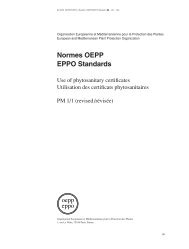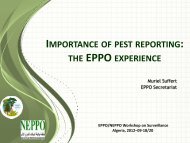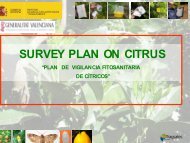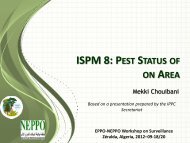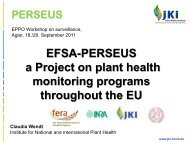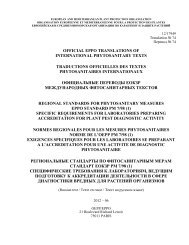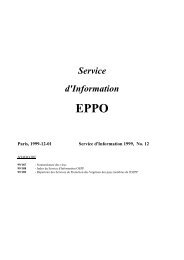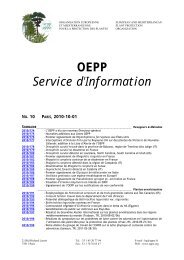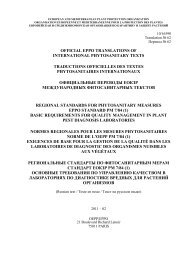EPPO Reporting Service - Lists of EPPO Standards - European and ...
EPPO Reporting Service - Lists of EPPO Standards - European and ...
EPPO Reporting Service - Lists of EPPO Standards - European and ...
Create successful ePaper yourself
Turn your PDF publications into a flip-book with our unique Google optimized e-Paper software.
<strong>EPPO</strong> <strong>Reporting</strong> <strong>Service</strong> – Pests & Diseases<br />
Labanowski G, Soika G (2002) The present problems in ornamental plant protection<br />
against pests. Progress in Plant Protection 42(1), 188-195.<br />
Llorens Climent JM (2009 Relación de nuevas plagas de cultivos encontradas en<br />
España en los últimos diez años. Phytoma España no. 212, 50-56.<br />
Pellizzari G, Vacante V (2007) A new armoured scale on Italian citrus trees:<br />
Chrysomphalus aonidum (Linnaeus). Informatore Fitopatologico 57(1), 45-47.<br />
Stathas GJ, Kozár F (2005-2006) Chrysomphalus aonidum as a pest <strong>of</strong> citrus in<br />
Greece. Entomologia Hellenica 16, 16-21.<br />
Additional key words: detailed record Computer codes: CHRYFI, IT<br />
2010/013 Isolated finding <strong>of</strong> Thaumatotibia (Cryptophlebia) leucotreta on<br />
Capsicum chinensis in the Netherl<strong>and</strong>s<br />
The NPPO <strong>of</strong> the Netherl<strong>and</strong>s recently informed the <strong>EPPO</strong> Secretariat <strong>of</strong> the first record <strong>of</strong><br />
Thaumatotibia leucotreta (Lepidoptera: Tortricidae - false codling moth) in a Dutch<br />
glasshouse on Capsicum chinense (Habanero chilli pepper). A crop inspection had been<br />
conducted in this glasshouse to trace-back an interception <strong>of</strong> T. leucotreta which had been<br />
made by the USA on C. chinense fruits imported from the Netherl<strong>and</strong>s. On 2009-10-07, 1<br />
larva <strong>of</strong> T. leucotreta was detected in a C. chinense fruit (not yet harvested) which was<br />
deformed. The Dutch NPPO explained that the production facility <strong>of</strong> this grower was<br />
connected to a packaging area in which capsicum fruits originating from Ug<strong>and</strong>a were<br />
regularly processed <strong>and</strong> packed. The grower usually imported C. chinense fruits from<br />
Ug<strong>and</strong>a from mid-November until March, <strong>and</strong> C. annuum fruits from Ug<strong>and</strong>a during the<br />
whole year. Therefore, it was considered most likely that a consignment <strong>of</strong> infected<br />
peppers had caused the introduction <strong>of</strong> T. leucotreta into the production facility.<br />
T. leucotreta is a polyphagous pest which feeds on more than 70 plant species, including<br />
important crops such as: Citrus spp., Capsicum spp., Gossypium hirsutum (cotton), Persea<br />
americana (avocado), Phaseolus spp., Prunus spp., Vitis spp. (grapevine), Olea spp., <strong>and</strong><br />
Zea mays. Damage is mainly caused by larvae feeding inside the fruits. In some crops, such<br />
as on C. chinense, fruit deformation can be observed. T. leucotreta is known to occur in<br />
many African countries, south <strong>of</strong> the Sahara. The insect can be found on its host crops<br />
throughout the year in tropical <strong>and</strong> sub-tropical climates (without diapause). Larvae feed<br />
inside the fruits <strong>and</strong> then fall to the soil surface to pupate. T. leucotreta is a multivoltine<br />
species. For example, in South Africa where the pest breeds all year-round on oranges (C.<br />
sinensis), up to 6 generations per year have been observed.<br />
A preliminary Pest Risk Analysis (PRA) has been conducted <strong>and</strong> concluded that the pest was<br />
unlikely to establish outdoors in the Netherl<strong>and</strong>s <strong>and</strong> that it presented a low risk for the<br />
country. However, a fuller PRA was to be conducted by the Dutch NPPO before the end <strong>of</strong><br />
2009. The grower <strong>of</strong> the infested site has taken control measures to eradicate T.<br />
leucotreta from the premises. Growers <strong>and</strong> traders have been informed about this finding<br />
<strong>and</strong> the possible risks associated with the imports <strong>of</strong> Capsicum spp. from Africa <strong>and</strong> a<br />
surveillance programme using pheromone traps will be implemented.<br />
The pest status <strong>of</strong> Thaumatotibia leucotreta in the Netherl<strong>and</strong>s is <strong>of</strong>ficially declared as:<br />
Absent, isolated finding, only detected on Capsicum chinense.<br />
Source: NPPO <strong>of</strong> the Netherl<strong>and</strong>s, 2009-11.<br />
Additional key words: phytosanitary incident Computer codes: ARGPLE, NL<br />
15




